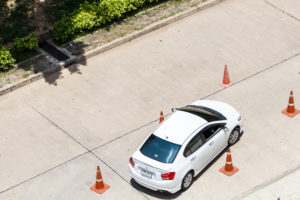For these reasons, a good driving school will deliver their lessons utilizing a mix of these techniques. However, the best driving school will take the time to understand each student’s unique learning style and cater the lesson plan to them. Any competent driving school curriculum will contain both didactic classroom learning of specific driving laws and regulations as well as hands-on driving instruction.
The goal of the classroom component of driving school is to create knowledgeable and safe drivers. Driving is a privilege, not a right, and with that privilege comes the responsibility of knowing state laws and regulations as they pertain to motorists. The best driving academy will teach:
• Basic road signage, symbols, and meaning
• Specific state and local laws regarding safe driving practices, yielding for emergency vehicles, etc.
• State and local parking procedures and regulations
• Defensive driving techniques
• Basic car maintenance and upkeep
• Common errors for new drivers to avoid
• Common car emergencies and how to handle them
This is not an exhaustive list. The material will vary regionally, but in general a good driving school class will cover all these areas is at least some capacity.
Obviously, hands-on driving instruction will be a large component of any driving school. Qualified instructors carefully monitoring and guiding students through increasingly difficult courses and eventually onto the open road has been the gold standard from decades. Driving involves quite a bit of muscle memory and fine-motor movement. These are skills that can only be honed via practice and repetition.
At least, that used to be the case. In recent years, many schools have shifted at least some of their instruction towards simulations, also known as driving school games. With a driving simulation, a student can be placed in a much wider variety of situations and environments than would be safely possible with real life, on-the-road instruction. Students can experience hydroplaning on a
wet highway or regaining control of a truck skidding across black ice without ever being in danger. In this way, instructors are able to demonstrate and evaluate techniques for situations that would be far too dangerous to mimic in the real world. This helps drivers to be more aware of how to handle a car and avoid
car accidents. Obviously, driving school games will never take the place of real-world instruction. However, they are being increasingly used to supplement and augment instructional training for both new and experienced drivers.
One common factor for people to enroll in driving school is that they are able to take various driving tests at that school. Depending on the DMV, the waiting list for drivers license appointments can often be weeks or months out. Driving schools allow students to schedule a driving test at their pace and take the test with an instructor that they have grown comfortable with. Also, students are often able to take license testing in their own vehicle, which adds another level of comfort to an often nerve-wracking process.
In the process of choosing the right driving school for you, make sure the school you choose is legally able to administer the specific test or certification that you are hoping to attain. For example, not all driving school locations offer motorcycle instruction or CDL certification.

